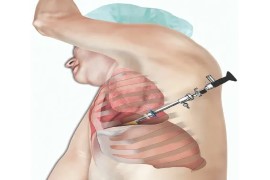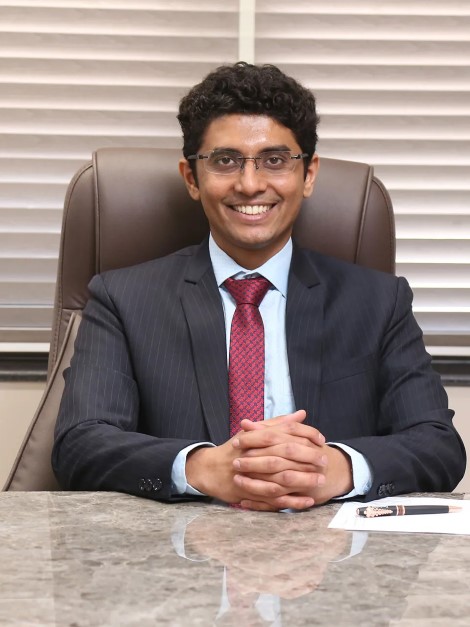Thoracoscopic & VATS Surgery
Thoracoscopic surgery, also known as video-assisted thoracoscopic surgery (VATS), is a minimally invasive surgical technique used to access and operate on structures within the chest cavity. It involves the use of a thoracoscope, which is a thin, flexible tube with a camera and surgical instruments, inserted through small incisions in the chest wall. VATS offers several advantages over traditional open surgery, including smaller incisions, reduced post-operative pain, shorter hospital stays, and faster recovery times.
What are the common symptoms of Thoracoscopic & VATS Surgery?
Thoracoscopic surgery, also known as video-assisted thoracoscopic surgery (VATS), is a minimally invasive surgical technique used for various thoracic procedures. The common symptoms experienced after thoracoscopic or VATS surgery can vary from person to person, but here are some typical symptoms:
- Pain and discomfort
- Shoulder or back pain
- Incision-related symptoms
- Fatigue
- Changes in breathing
- Limited mobility
- Residual gas pain
Types of Thoracoscopic & VATS Surgery?
VATS can be used for various thoracic procedures, including:
- Lobectomy: VATS lobectomy involves the removal of an entire lobe of the lung affected by conditions such as lung cancer or other lung diseases.
- Wedge Resection: In VATS wedge resection, a small, wedge-shaped piece of lung tissue is removed, typically for the removal of small lung nodules or to obtain a biopsy for diagnostic purposes.
- Thymectomy: VATS thymectomy is the surgical removal of the thymus gland, which is commonly performed for the treatment of thymoma (a tumor of the thymus gland) or myasthenia gravis (an autoimmune disorder).
- Decortication: VATS decortication involves the removal of the fibrous layer (pleural peel) that may develop around the lungs due to conditions such as empyema (accumulation of infected fluid in the pleural space) or pleural effusion (accumulation of fluid in the pleural space).
- Sympathectomy: VATS sympathectomy is a procedure performed to interrupt the sympathetic nerves in the chest, which can help relieve conditions such as hyperhidrosis (excessive sweating) or reflex sympathetic dystrophy.
- Esophageal Surgery: VATS can also be used for certain esophageal procedures, including esophageal diverticulectomy or Heller myotomy (for achalasia), where the thoracoscope is used to access the esophagus and perform the surgery.
How to prepare for Thoracoscopic & VATS Surgery?
- Preoperative assessment: Your healthcare team will conduct a thorough preoperative assessment, which may include blood tests, imaging scans, pulmonary function tests, and other evaluations. This assessment helps determine your overall health and suitability for surgery.
- Medical history and medications: Provide your healthcare team with a complete and accurate medical history, including any previous surgeries, current medications, allergies, and chronic conditions. Inform them about any medications you are taking, including prescription medications, over-the-counter drugs, and supplements. They will advise you on which medications to continue or stop before surgery.
- Smoking cessation: If you smoke, it is highly recommended to quit smoking prior to surgery. Smoking can increase the risk of complications during and after surgery. Talk to your healthcare team about smoking cessation programs or resources to help you quit.
- Medication adjustments: Some medications, such as blood thinners or antiplatelet drugs, may need to be adjusted or temporarily stopped before surgery to minimize bleeding risks. Follow your healthcare team's instructions regarding medication management leading up to the surgery.
- Nutritional evaluation: Good nutrition plays a crucial role in the healing process. Your healthcare team may recommend a nutritional evaluation and provide dietary recommendations to optimize your nutritional status before surgery. Maintain a balanced diet and follow any specific dietary instructions provided by your healthcare team.
- Exercise and breathing exercises: Engage in regular exercise as permitted by your healthcare team to improve your overall fitness and strengthen your respiratory muscles. Additionally, practicing deep breathing exercises and using an incentive spirometer can help optimize your lung function before surgery.
- Preoperative instructions: Follow any preoperative instructions provided by your healthcare team. This may include fasting guidelines (typically no food or drink after midnight the night before surgery), showering protocols, and specific instructions about medications or supplements to take or avoid.
- Arrange support: Arrange for a support system to assist you before and after surgery. This can involve having a family member or friend accompany you to the hospital, helping with daily activities, and providing emotional support.
- Inform your healthcare team: Inform your healthcare team about any changes in your health leading up to the surgery, such as the development of a cold, cough, or fever. These conditions may require further evaluation or a potential postponement of the surgery.
Best Doctor For Thoracoscopic & VATS Surgery In Ahmedabad
Dr. Manthan Merja (Patel)
MBBS, MS (Gen. Surgery) - B. J. Medical College.
MCh-Surgical Oncologist - GCRI, BJMC.
- FIOP (ESSO Europe)
- FARIS (Robotic Surgery)
- FALS (Robotic Surgery)
Dr. Manthan Merja is a consultant surgical oncologist in Ahmedabad. He is a qualified
oncologist with over 10 years of experience in the field. He is an expert in the
treatment of all types of cancer, including breast cancer, lung cancer, colorectal
cancer, and gastric cancer.
Dr. Merja completed his MBBS from BJ Medical College, Ahmedabad in 2012. He then went on
to complete his MS in General Surgery from the same college in 2015. In 2019, he
completed his MCh in Surgical Oncology from Gujarat Cancer & Research Institute.
FAQ About Thoracoscopic & VATS Surgery
-
What is the difference between thoracoscopic surgery and VATS?Thoracoscopic surgery and VATS (Video-Assisted Thoracic Surgery) are essentially the same. VATS is a specific type of thoracoscopic surgery that utilizes video technology to assist in performing minimally invasive procedures in the chest or thoracic cavity. The term VATS is often used interchangeably with thoracoscopic surgery.
-
How long does the recovery take after thoracoscopic or VATS surgery?The recovery time after thoracoscopic or VATS surgery can vary depending on the specific procedure performed, the individual's overall health, and the extent of the surgery. In general, the recovery period ranges from a few weeks to a few months. Your healthcare team will provide specific guidelines and monitor your progress during follow-up visits to assess your recovery.
-
What are the advantages of thoracoscopic or VATS surgery over traditional open surgery?Thoracoscopic or VATS surgery offers several advantages over traditional open surgery, including smaller incisions, reduced blood loss, decreased postoperative pain, shorter hospital stays, faster recovery times, and potentially fewer complications. The minimally invasive nature of these procedures can result in less trauma to the surrounding tissues and organs.


